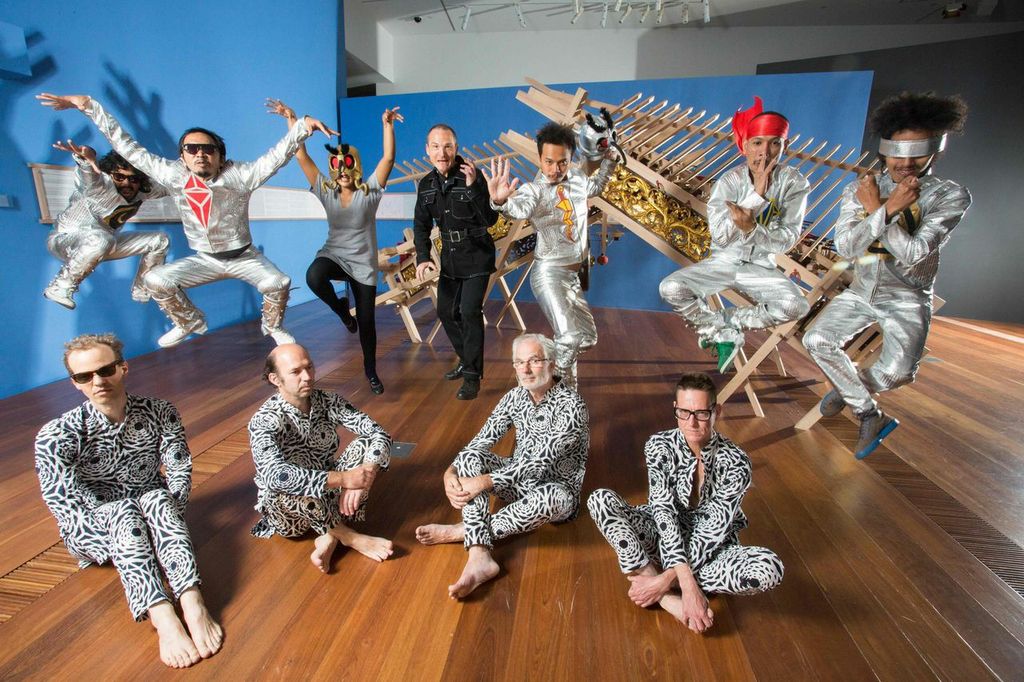“It’s hard to articulate,” he says. “It’s hard to encapsulate the synopsis without it leading to more questions.” To make a sci-fi-meets-alien-moths-meets- Javanese-mysticism visual/video /musical/installation performance experience, take the following ingredients: one Sedulur Gamelan – a self-governing electrical piano contraption made of two interlocking wooden structures containing 56 different traditional Indonesian musical instruments (“it suggests an 18th century double grand piano,” explains Kesminas). The Gamelan plays itself, performing transcriptions of Indonesian, American and Australian experimental music and avant-garde sound-art of the 1970s and 1980s. Add the 40 strong Astra choirunder the musical direction of John McCaughey; Punkasila, an Indonesian mystic art music punk band; world renowned classical pianist Michael Kieran Harvey; singer/dancer Rachel Saraswati and include projected illustrations and film by Yogyakarta artists Erwan ‘Iwank,’ Hersi Susanto and Terra Bajraghosa. Method: combine the above.
“It seems inconceivable but it’s interesting how it goes together; we’ve done it twice already,” says Kesminas, who is a member of both Slave Pianos (a collective devoted to the exhibition, collection, analysis, recomposition and performance of sound work by visual artists) and Punkasila. “It happened at MONA FOMO and we performed it last month in Yogyakarta with an all-girl Gamelan ensemble. When you see it, there is some degree of coherence. There is a through-line – a narrative about the lepidopters.” So, why? “It’s the opportunity to bring the two groups – Slave Pianos and Punkasila – together,” says Kesminas. “I’m a member of both. The whole project is very complicated: it’s a response to a commissioned science fiction text by Cologne-based American writer, Mark von Schlegell. He’d written about Slave Pianos about ten years ago when he was in Australia. It’s been my long-term intention to make a response to a text of his.” The Lepidopters: A Space Opera includes self-referential comics about Punkasila in the Lepidoptera story, created by the group and made into an animation. “It’s a cross cultural collaboration,” Kesminas continues. “With the artwork of the moth monsters, it’s amazing how the Indonesians gave shape to Mark’s vision.” What sort of effect will the performance have on audiences? “It’s a beautiful sensual assault,” answers Kesminas. “A rewarding disturbing experience, it’s a theatrical spectacular musical.”
The Lepidopters isn’t actually the manifestation of one man’s spectacular acid trip; according to Kesminas, it’s collaboration on all levels. “These things have their own momentum,” he notes. “It’s evolved into mystic mysterious ways. It’s been an unpredictable expansive collaborative process. It’s far more interesting than anything you could envisage!” There are travels throughout time as well as genre; The Lepidopters blends history, culture and geography, including western music from the 17th century. The creative energy of Yogyakarta, Indonesia’s cultural centre and the home of Punkasila, is, according to Kesminas, a continually dynamic surprising influence. “Yogyakarta’s a perfect place to work, you can let stuff loose; it’s a crucible of creativity,” he says. “It’s the youth go-to place for doing stuff.”
So what will audiences actually experience in The Lepidopters? “It’s an immersive experience,” answers Kesminas. “It’s a blend of high and low art. The logic of opera suggests a text, the idea of a libretto, with visuals and sound. With the space element you have the comic playful aspect. Some parts of it are very serious, not in a pretentious way, more in a thoughtful considered sense. Light displays illuminate secret codes. You hear electric space drums, a mic machine processing two singers’ voices, an animation by video artist, Terra. There are lots of Javanese references in the video,” Kesminas adds. “An MTC actor, Richard Piper narrates, giving the whole thing a narrative thread.”
Punkasila is an Indonesian multi-faceted post-punk art band whose customised instruments are ‘just-intonation’ tuned, giving them an unusual electronic sound matching the sounds of the Gamelan. Its line-up changes constantly; none of the founding members remain. The six musicians perform in silver space suits. Kesminas has travelled with Punkasila to the US and Cuba as well as touring Australia and Indonesia. “It’s not just a band,” he explains. “They do art work, paintings, sculptures, videos. When we toured to Havana they documented the visit via comics.” The multi-art-form concert draws on the work of Robert Smithson, including projections of his project proposals from throughout his career,to explore sonic landscapes and dystopian visions, Indonesian telepathy, ancient Javanese mysticism and art practices traditional and modern, as well as different genres of musical performance.
What has Kesminas learnt about himself while putting together this epic performance? “How little I know!” is his answer.
BY LIZA DEZFOULI

